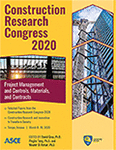Construction Research Congress 2020
Evaluation of Resilient Practices for Capital Project Planning under Variable Budget Constraints
Publication: Construction Research Congress 2020: Project Management and Controls, Materials, and Contracts
ABSTRACT
Capital project planning is critical for project owners to decide how to allocate limited resources to meet the project needs for public universities in the U.S. It is an iterative process for planners to accommodate different project goals, while the budget realization is uncertain due to reasons such as unexpected funding cuts and weak justifications for funding requests. When funding levels are uncertain, public owners may have to follow alternative planning processes with practices that enable the planning outcome to be more resilient under variable budget constraints. This study defines the implications of resilience in the context of capital project planning. The budget issue is addressed via two criteria of planning resilience: integration of planning needs and variability of requested budgets. We develop a conceptual framework that encompasses these two criteria to evaluate the resilience of planning practices against potential budget cuts. Literature review and interviews with architects and planners from a public university were conducted to identify resilient planning practices that can be implemented when funding is uncertain. Lastly, whether the planning practices resist the project’s vulnerability of variable budget constraints will be evaluated using the proposed criteria for planning resilience.
Get full access to this article
View all available purchase options and get full access to this chapter.
REFERENCES
Almufti, I., and Willford, M. (2014). The REDi™ Rating System: “A framework to implement resilience-based earthquake design for new buildings.” In Tenth US National Conference on Earthquake Engineering Frontiers of Earthquake Engineering 10NCEE Anchorage, July 21-25, 2014, Alaska.
Amer, M., Daim, T. U., and Jetter, A. (2013). “A review of scenario planning.” Futures, 46, 23-40.
Bingham, E., and Gibson, G. E. Jr (2016). “Infrastructure project scope definition using project definition rating index.” Journal of management in engineering, 33(2), 04016037.
Bruneau, M., Chang, S.E., Eguchi, R.T., Lee, G.C., O”Rourke, T.D., Reinhorn, A.M., Shinozuka, M., Tierney, K.T., Wallace, W.A. and von Winterfeldt, D. (2003). “A framework to quantitatively assess and enhance the seismic resilience of communities.” Earthquake Spectra, 19 (4), 733–752.
Caffieri, J. J., Love, P. E., Whyte, A., and Ahiaga-Dagbui, D. D. (2018). “Planning for production in construction: controlling costs in major capital projects.” Production Planning & Control, 29(1), 41-50.
FEMA P-58, “Seismic performance assessment of buildings.” (2012). Volume 1 – Methodology and Volume 2 – Implementation Guide, September 2012.
Garvin, M. J., Wooldridge, S. C., Miller, J. B., and McGlynn, T. H. M. J. (2000). “Capital planning system applied to municipal infrastructure.” Journal of management in engineering, 16(5), 41-50.
George, R., Bell, L. C., and Edward Back, W. (2008). “Critical activities in the front-end planning process.” Journal of Management in Engineering, 24(2), 66-74.
Gibson, G. E. Jr, Kaczmarowski, J. H., and Lore, H. E. Jr (1995). “Preproject-planning process for capital facilities.” Journal of construction engineering and management, 121(3), 312-318.
Griffith, A. F., and Gibson, G. E. Jr (2001). “Alignment during pre-project planning.” Journal of Management in Engineering, 17(2), 69-76.
Hamilton, M. R., and Gibson, G. E. Jr (1996). “Benchmarking preproject planning effort.” Journal of Management in Engineering, 12(2), 25-33.
Hollnagel, E., Woods, D.D., and Leveson, N. (Eds.) (2006). Resilience engineering: concepts and precepts. Aldershot: Ashgate.
Ing, C. D. R. E., Baker, C. J., FIHT, F., AcSS, F. R. G. S., GHEA, M., DIS, D. N. C., Ian Jefferson, D.I.S. and CMath, C. (2012). “Resistance and resilience-paradigms for critical local infrastructure.” Proceedings of the Institution of Civil Engineers, 165(2), 73.
Kellerer, H., Pferschy, U., and Pisinger, D. (2004). Knapsack Problems. Springer-Verlag, Heidelberg.
Koc, A., Morton, D. P., Popova, E., Hess, S. M., Kee, E., and Richards, D. (2009). “Prioritizing project selection.” The Engineering Economist, 54(4), 267-297.
Meyer, W. G. (2014). “The effect of optimism bias on the decision to terminate failing projects.” Project Management Journal, 45 (4): 7–20.
Rose, A. (2007). “Economic resilience to natural and man-made disasters: Multidisciplinary origins and contextual dimensions.” Environmental Hazards, 7(4), 383-398.
Seyoum, K. (2009). “Dynamic comprehensive strategic planning: Integrated land development, public facility capacity planning, and capital budgeting decision analysis framework.” Leadership and Management in Engineering, 9(1), 26-31.
Woods, D. D. (2015). “Four concepts for resilience and the implications for the future of resilience engineering.” Reliability Engineering & System Safety, 141, 5-9.
Information & Authors
Information
Published In
Construction Research Congress 2020: Project Management and Controls, Materials, and Contracts
Pages: 105 - 114
Editors: David Grau, Ph.D., Arizona State University, Pingbo Tang, Ph.D., Arizona State University, and Mounir El Asmar, Ph.D., Arizona State University
ISBN (Online): 978-0-7844-8288-9
Copyright
© 2020 American Society of Civil Engineers.
History
Published online: Nov 9, 2020
Published in print: Nov 9, 2020
Authors
Metrics & Citations
Metrics
Citations
Download citation
If you have the appropriate software installed, you can download article citation data to the citation manager of your choice. Simply select your manager software from the list below and click Download.
